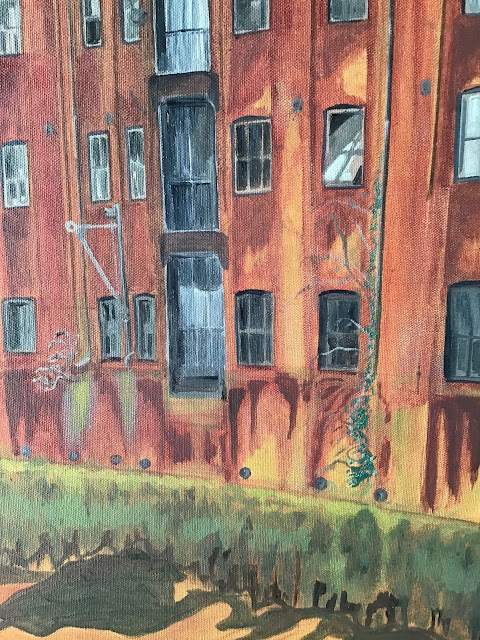"Docklands", monoprint using acrylic paint
Introduction
I have continued experimenting with monoprints due to the continued "lockdown" situation. I aim to use this period to learn new skills which I can build into my practice.
Monoprinting with acrylic paint (using masks/stencils)
The image is created using a simple image. Dried flowers and leaves etc. may also be incorporated into the process and used as a stencil.
Process
- Find a piece of cardboard to create a window/frame
- Cut out a square 20cm x 20cm (a handy size as A4 paper in half fits this size of window)
- Apply PVA glue around the edge to make water tight window
- Draw out an image in pencil on a piece of paper (the same size)
- Cut out sections of shapes to create masks
- Take a piece of heavy printing paper
- Tape the printing paper onto the back of the prepared frame
- Create a palette of acrylic paints
-Work quickly as acrylics dry quickly
- Create a pad of soft scrim to hold and apply the paint
- Use the edges of the masks and plants as a marker
- Apply the acrylic paint with the pad and work around the edges, stamping into the surface
- Take away the mask
- Add different colours to the print by using the edges of the other masks as a guide
- Build up image and definition in layers of acrylic
- May add other shapes and objects to enhance the image
- Work colour in between stencils and lift off
- May use as many colours and layers as you want
- Let print dry
- Take tape off the back of the image
- The finished print may be used as a base to paint on top of parts if desired.
Sketch
Sketch cut into shapes and dried leaves added
Inking process using the masks as guide
Monoprinting with Collage
Final print
Process
- Use etching ink as more translucent (can use relief ink)
- Choose a simple image
- Make three collages for three different parts of the total image and for three different colours
- Ensure all images are exact copies of the main drawing (use tracing paper)
- If using mountboard can use shellac to seal (not essential)
- Cut out any areas to be white on each collage in exactly the same place using a scalpel
- Stick on some other pieces of paper/card/other materials for the darker areas to be inked
- Over print each collage with each colour separately
- Mark up three sheets of paper with register marks to match up each separate collage
- Roll out the colour for the first image
- Roll ink onto first collage
- Place collage on registration mark
- place paper on top
- Work back of paper with spoon or baren
- Take paper off and set aside (the paper will be re-used to overprint the remaining two collages with two additional colours)
- Repeat the above process using the two remaining collages and colours
The three prepared collages
Any left over ink may be used as follows:
- Roll the remaining ink onto dried leaves/shapes/ feather etc.
- Take a piece of paper
- Lay the objects on the paper next to each other
- Place a piece of printing paper on top
- Roll with a dry roller
- simple prints can be produced like this
Summary
The acrylic monoprinting produced a better result than using the collages.The acrylic paint allowed me to work freely and build up an image as I went along. It was more akin to a painting process. The collage method of monoprinting involved a lot of preparation, which I did not think was reflected in the finished print. A lot of detail was lost. The process was more rigid and the finished print was not well defined. I will try the acrylic paint method again, but perhaps not the collage method, for the reasons given. I may try just creating one collage instead, and see if that produces a better result.






























